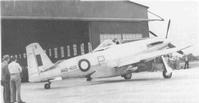


Chapter 7
I The First 100 Years 1788-1888
II Railways
III Motorised Vehicles
IV Aviation
i Local Inventions, Research, Design and Manufacture
ii The Development of Air Transport: The Trail Blazers
iii The Services
iv The Royal Flying Doctor Service
v Ground Aids and Safety Innovations
vi From Aviation to Modern Shipping
V Modern Shipping
VI Innovative Small Craft
VII Conclusion
VIII Acknowledgements
IX Contributors
References
Index
Search
Help
Contact us

Local Inventions, Research, Design and Manufacture (continued)
The nucleus of the newly formed company was provided by L. J. Wackett's team, operating at the Tugan Aircraft premises in Sydney. This company was taken over by CAC and Wackett became its first manager. A factory was constructed at Fishermen's Bend in Melbourne and Wackett began to operate from the new premises in September, 1937.In order to enable rapid local production, a licenced design was adopted, both for the airframe (the North American NA33, later known as the Wirraway), and for the engine (Pratt and Whitney Wasp).[15]
Whilst this is a historical review, in these days of rampant Canberra bureaucracy it is interesting to note the speed with which it was possible to operate when there were no government departments set up to 'assist' industry. Thus the first order was received in January 1937, some nine months before the factory was completed (this took less than a year) and the first aircraft and its engine were completed in March 1939, some 18 months after the factory started operating.[16] A total of 755 Wirraways were built in subsequent war years.
In 1938 a requirement for an intermediary trainer for the R.A.A.F. arose and the Wackett team designed and built the Wackett trainer, which first flew in October 1939. It was subsequently re-engined and some 200 production trainers were built, with deliveries occurring between May 1941 and April 1942.[17]
An interesting and innovative CAC design was the Woomera three seater reconnaissance bomber. Engineering work on this aircraft commenced in April 1940 and the first flight took place in September 1941. The Woomera had a number of ingenious features incorporated, the most interesting being the remotely controlled, power-operated gun turrets at the rear of each engine nacelle. Due to a change of government policy, this type was not ordered into production.[18]
In order to counteract the supremacy of the Japanese Air Force in 1942, the CAC design staff employed the most powerful engine then available, the 1200 h.p. twin Wasp to power a new design of a small fighter. To save time, many existing Wirraway components were incorporated in the new design. The new aircraft, named the Boomerang, first flew at the end of May 1942, precisely 14 weeks after rough drafts had been approved. 105 aircraft of this type were ordered off the drawing board and first production aircraft were delivered to the R.A.A.F. by September 1942. Further versions of the Boomerang had supercharged engines and a total of 250 aircraft of both types were built.[19]
The design of an advanced fighter (known as the CA15) commenced in July 1942 (Fig. 26). It was originally designed for a U.S. engine, the 2,300 h.p. Pratt and Whitney R-2800, but this engine was not made available and the aircraft was re-designed in 1945 to accept the Rolls Royce Griffon engine. The first flight occurred in March 1946. Whilst the advent of jet fighters prevented the CA-15 to be ordered for production, it was, for its time, a remarkable performance aircraft and was definitely a state-of-the-art development.[20]

Organisations in Australian Science at Work - Commonwealth Aircraft Corporation (C.A.C.); Royal Australian Air Force (R.A.A.F.); Tugan Aircraft Company, Mascot
People in Bright Sparcs - Schaetzel, Stanley S.; Wackett, L. J.
 |
Australian Academy of Technological Sciences and Engineering |  |
© 1988 Print Edition pages 506 - 507, Online Edition 2000
Published by Australian Science and Technology Heritage Centre, using the Web Academic Resource Publisher
http://www.austehc.unimelb.edu.au/tia/500.html